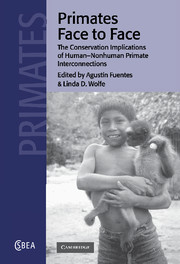Book contents
- Frontmatter
- Contents
- List of contributors
- Foreword
- Acknowledgements
- Introduction
- Part 1 Science and nonhuman primates
- Part 2 Cultural views of nonhuman primates
- Part 3 Conservation of nonhuman primates
- Part 4 Government actions, local economies and nonhuman primates
- 13 The primatologist as minority advocate
- 14 Monkey business? The conservation implications of macaque ethnoprimatology in southern Thailand
- 15 Rhesus macaques: a comparative study of two sites, Jaipur, India, and Silver Springs, Florida
- Index
14 - Monkey business? The conservation implications of macaque ethnoprimatology in southern Thailand
Published online by Cambridge University Press: 20 October 2009
- Frontmatter
- Contents
- List of contributors
- Foreword
- Acknowledgements
- Introduction
- Part 1 Science and nonhuman primates
- Part 2 Cultural views of nonhuman primates
- Part 3 Conservation of nonhuman primates
- Part 4 Government actions, local economies and nonhuman primates
- 13 The primatologist as minority advocate
- 14 Monkey business? The conservation implications of macaque ethnoprimatology in southern Thailand
- 15 Rhesus macaques: a comparative study of two sites, Jaipur, India, and Silver Springs, Florida
- Index
Summary
Ethnoprimatology
Three main reasons for studying nonhuman primates have long been recognized by anthropologists and others: our closest living relatives in the animal kingdom are primates; our ancestors were primates; and we are also primates (see, for example, Darwin, 1871, 1872; Huxley, 1863; Morris, 1967). Recently, a fourth reason for studying nonhuman primates is increasingly being recognized: humans interact with nonhuman primate species in multifarious, fascinating, and important ways, especially where they are sympatric.
The term ethnoprimatology was coined to refer to research on interactions between human and nonhuman primate populations in regions where they are sympatric species. Ethnoprimatology operates at the interface of cultural anthropology (ethnography) and primatology (field study of primate behavior, ecology, and conservation) (Sponsel, 1997a).
The recency and neglect of ethnoprimatology reflects several factors. Among these is the paradox that, whereas humans have long been accepted by most scientists as a product of organic evolution, seldom have biologists and others accepted any human populations as a natural and integral part of ecosystems. This even applies to those ‘traditional’ indigenous societies who live sustainably with their environment. Primate fieldwork has mostly focused on the unintrusive naturalistic observation of the behavior and ecology of free-ranging primates, ideally in areas where human influence or interference is absent or minimal (Carpenter, 1964).
- Type
- Chapter
- Information
- Primates Face to FaceThe Conservation Implications of Human-nonhuman Primate Interconnections, pp. 288 - 309Publisher: Cambridge University PressPrint publication year: 2002
- 26
- Cited by



